Anisotropic Piezoelectric Properties of Porous (Ba0.85Ca0.15)(Zr0.1Ti0.9)O3 Ceramics with Oriented Pores through TBA-Based Freeze-Casting Method
Abstract
:1. Introduction
2. Experimental Section
3. Results and Discussion
4. Conclusions
Author Contributions
Funding
Institutional Review Board Statement
Informed Consent Statement
Data Availability Statement
Conflicts of Interest
References
- Bowen, C.R.; Taylor, J.; LeBoulbar, E.; Zabek, D.; Chauhan, A.; Vaish, R. Pyroelectric materials and devices for energy harvesting applications. Energy Environ. Sci. 2014, 7, 3836–3856. [Google Scholar] [CrossRef] [Green Version]
- Wada, S.; Mase, Y.; Shimizu, S.; Maeda, K.; Fujii, I.; Nakashima, K.; Pulpan, P.; Miyajima, N. Piezoelectric properties of porous potassium niobate system ceramics. Key Eng. Mater. 2011, 485, 61–64. [Google Scholar] [CrossRef]
- Gaihre, B.; Jayasuriya, A.C. Comparative investigation of porous nano-hydroxyapaptite/chitosan, nano-zirconia/chitosan and novel nano-calcium zirconate/chitosan composite scaffolds for their potential applications in bone regeneration. Mater. Sci. Eng. C 2018, 91, 330–339. [Google Scholar] [CrossRef] [PubMed]
- Shi, Z.M.; Cao, Y.S.; Araújo, A.J.; Zhang, P.; Lou, Z.; Qin, M.; Xu, J.; Gao, F. Plate-like Ca3Co4O9: A novel lead-free piezoelectric material. Appl. Surf. Sci. 2021, 536, 147928. [Google Scholar] [CrossRef]
- Saeidi, B.; Derakhshandeh, M.R.; Chermahini, M.D.A. Doostmohammadi, Novel porous barium titanate/nano-bioactive glass composite with high piezoelectric coefficient for bone regeneration applications. J. Mater. Eng. Perform. 2020, 29, 5420–5427. [Google Scholar] [CrossRef]
- Srikanth, K.S.; Singh, V.P.; Vaish, R. Pyroelectric performance of porous Ba0.85Sr0.15TiO3 ceramics. Int. J. Appl. Ceram. Technol. 2018, 15, 140–147. [Google Scholar] [CrossRef]
- Chen, C.F.; Zhu, Y.; Ji, J.; Cai, F.X.; Zhang, Y.M.; Zhang, N.Y.; Wang, A.D. Fabrication and performance of porous lithium sodium potassium niobate ceramic. Mater. Res. Express 2018, 5, 025404. [Google Scholar] [CrossRef]
- Dong, S.J.; Zhu, W.Z.; Gao, X.L.; Wang, Z.; Wang, L.Y.; Wang, X.Y.; Gao, C.J. Preparation of tubular hierarchically porous silicate cement compacts via a tertbutyl alcohol (TBA)-based freeze casting method. Chem. Eng. J. 2016, 295, 530–541. [Google Scholar] [CrossRef]
- Galassi, C. Processing of porous ceramics: Piezoelectric materials. J. Eur. Ceram. Soc. 2006, 26, 2951–2958. [Google Scholar] [CrossRef]
- Pinheiro, E.; Deivarajan, T. A concise review encircling lead free porous piezoelectric ceramics. Acta Phys. Pol. A 2019, 136, 555–565. [Google Scholar] [CrossRef]
- Wang, N.; Liu, Y.S.; Zhang, Y.; Du, Y.; Zhang, J.Z. Control of pore structure during freeze casting of porous SiC ceramics by different freezing modes. Ceram. Int. 2019, 45, 11558–11563. [Google Scholar] [CrossRef]
- Liu, W.F.; Ren, X.B. Large piezoelectric effect in Pb-free ceramics. Phys. Rev. Lett. 2009, 103, 257602. [Google Scholar] [CrossRef] [PubMed] [Green Version]
- Ye, S.K.; Fuh, J.; Lu, L. Structure and electrical properties of <001> textured (Ba0.85Ca0.15)(Ti0.9Zr0.1)O3 lead-free piezoelectric ceramics. Appl. Phys. Lett. 2012, 100, 252906. [Google Scholar] [CrossRef]
- Zhao, Z.; Li, X.; Dai, Y.; Ji, H.; Su, D. Highly textured Ba0.85Ca0.15Ti0.90Zr0.10O3 ceramics prepared by reactive template grain growth process. Mater. Lett. 2016, 165, 131–134. [Google Scholar] [CrossRef]
- Chandrakala, E.; Praveen, J.P.; Das, D. Effect of poling process on piezoelectric properties of BCZT-0.08 wt.% CeO2 lead-free ceramics. AIP. Conf. Proc. 2016, 1728, 020502. [Google Scholar]
- Zhang, Y.; Roscow, J.; Lewis, R.; Khanbareh, H.; Topolov, V.Y.; Xie, M.; Bowen, C.R. Understanding the effect of porosity on the polarisation-field response of ferroelectric materials. Acta Mater. 2018, 154, 100–112. [Google Scholar] [CrossRef] [Green Version]
- Wang, Z.; Feng, P.; Wang, X.; Geng, P.; Akhtar, F.; Zhang, H. Fabrication and properties of freeze-cast mullite foams derived from coal-series kaolin. Ceram. Int. 2016, 42, 12414–12421. [Google Scholar] [CrossRef]
- Li, B.; Ehmke, M.C.; Blendell, J.E.; Bowman, K.J. Optimizing electrical poling for tetragonal, lead-free BZT-BCT piezoceramic alloys. J. Eur. Ceram. Soc. 2013, 33, 3037–3044. [Google Scholar] [CrossRef]
- Miura, K.; Azuma, M.; Funakubo, H. Electronic and structural properties of ABO3: Role of the BO coulomb repulsions for ferroelectricity. Materials 2011, 4, 260–273. [Google Scholar] [CrossRef]
- Chandrakala, E.; Praveen, J.P.; Hazra, B.K. Effect of sintering temperature on structural, dielectric, piezoelectric and ferroelectric properties of sol-gel derived BZT-BCT ceramics. Ceram. Int. 2016, 42, 4964–4977. [Google Scholar] [CrossRef]
- Singh, A.K.; Goel, T.; Mendiratta, R.; Thakur, O.; Prakash, C. Dielectric properties of Mn-substituted Ni-Zn ferrites. J. Appl. Phys. 2002, 91, 6626–6629. [Google Scholar] [CrossRef]
- Fukushima, M.; Fujiwara, T.; Fey, T.; Kakimoto, K.-i. One- or two- dimensional channel structures and properties of piezoelectric composites via freeze-casting. J. Am. Ceram. Soc. 2017, 100, 5400–5408. [Google Scholar] [CrossRef]
- Bowen, C.R.; Kara, H. Pore anisotropy in 3-3 piezoelectric composites. Mater. Chem. Phys. 2002, 75, 45–49. [Google Scholar] [CrossRef]
- Victor, P.; Ranjith, R.; Krupanidhi, S.B. Normal ferroelectric to relaxor behavior in laser ablated Ca-doped barium titanate thin films. J. Appl. Phys. 2003, 94, 7702–7709. [Google Scholar] [CrossRef]
- Shannon, R.D. Revised effective ionic radii and systematic studies of interatomic distances in halides and chalcogenides. Acta Crystallogr. Sect. A 1976, 32, 751. [Google Scholar] [CrossRef]
- Li, S.B.; Zhang, L.M.; Wang, C.B. Structural, dielectric and ferroelectric properties of lead-free Ba0.85Ca0.15Zr0.10Ti0.90O3 ceramics prepared by Plasma Activated Sintering. Ceram. Int. 2016, 42, 18585–18591. [Google Scholar] [CrossRef]
- Hao, J.; Bai, W.; Li, W. Correlation between the microstructure and electrical properties in high performance (Ba0.85Ca0.15)(Zr0.1Ti0.9)O3 lead-free piezoelectric ceramics. J. Am. Ceram. Soc. 2012, 95, 1998–2006. [Google Scholar] [CrossRef]
- Coondoo, I.; Panwar, N.; Amorín, H. Synthesis and characterization of lead-free 0.5Ba(Zr0.2Ti0.8)O3-0.5(Ba0.7Ca0.3)TiO3 ceramic. J. Appl. Phys. 2013, 113, 214107. [Google Scholar] [CrossRef] [Green Version]
- Uchino, K.; Nomura, S. Critical exponents of the dielectric constants in diffused-phase-transition crystals. Ferroelectrics 1982, 44, 55–61. [Google Scholar] [CrossRef]
- Okazaki, K.; Nagata, K. Effects of grain size and porosity on electrical and optical properties of PLZT ceramics. J. Am. Ceram. Soc. 1973, 56, 82–86. [Google Scholar] [CrossRef]
- Tan, Q.; Viehland, D. Grain size dependence of relaxor characteristics in La-modified lead zirconate titanate. Ferroelectrics 1997, 193, 157–165. [Google Scholar] [CrossRef]
- Hanani, Z.; Mezzane, D.; Amjoud, M.; Fourcade, S.; Razumnaya, A.G.; Luk’Yanchuk, I.A.; Gouné, M. Enhancement of dielectric properties of lead-free BCZT ferroelectric ceramics by grain size engineering. Superlattices Microst. 2019, 127, 109–117. [Google Scholar] [CrossRef] [Green Version]
- Khachaturyan, R.; Zhukov, S.; Galassi, C.; Reimuth, C.; Koruza, J. Polarization-switching dynamics in bulk ferroelectrics with isometric and oriented anisometric pores. J. Phys. D 2017, 50, 045303. [Google Scholar] [CrossRef]
- Roscow, J.I.; Zhang, Y.; Kraśny, M.J. Freeze cast porous barium titanate for enhanced piezoelectric energy harvesting. J. Phys. D 2018, 51, 225301. [Google Scholar] [CrossRef] [Green Version]
- Zhang, Y.; Xie, M.; Roscow, J.; Bao, Y.X.; Zhou, K.; Zhang, D.; Bowen, C.R. Enhanced pyroelectric and piezoelectric properties of PZT with aligned porosity for energy harvesting applications. J. Mater. Chem. A 2017, 5, 6569–6580. [Google Scholar] [CrossRef] [PubMed] [Green Version]
- Xu, T.T.; Wang, C.A. Effect of two-step sintering on micro-honeycomb BaTiO3 ceramics prepared by freeze-casting process. J. Eur. Ceram. Soc. 2016, 36, 2647–2652. [Google Scholar] [CrossRef]
- Zhang, M.; Sun, H.; Liu, X.; Sui, H.; Xiao, S. Structural design of PZT porous ceramics obtained via free-casting by ice-templating and performance exploration. Mater. Res. Bull. 2020, 127, 110862. [Google Scholar] [CrossRef]
- Zhang, Y.; Xie, M.; Roscow, J.; Bowen, C.R. Dielectric and piezoelectric properties of porous lead-free 0.5Ba(Ca0.8Zr0.2)O3-0.5(Ba0.7Ca0.3)TiO3 ceramics. Mater. Res. Bull. 2019, 112, 426–431. [Google Scholar] [CrossRef]
- Eichhorn, F.; Biggemann, J.; Kellermann, S.; Kawai, A.; Kato, K.; Kakimoto, K.; Fey, T. Influence of cell size on mechanical and piezoelectric properties of PZT and LNKN ceramic foams. Adv. Eng. Mater. 2017, 19, 1700420. [Google Scholar] [CrossRef]
- Guo, R.; Wang, C.A.; Yang, A.K. Piezoelectric properties of the 1-3 type porous lead zirconate titanate ceramics. J. Am. Ceram. Soc. 2011, 94, 1794–1799. [Google Scholar] [CrossRef]
- Della, C.N.; Shu, D. The performance of 1-3 piezoelectric composites with a porous non-piezoelectric matrix. Acta Mater. 2008, 56, 754–761. [Google Scholar] [CrossRef]
- Xu, T.T.; Wang, C.A. Grain orientation and domain configuration in 3-1 type porous PZT ceramics with ultrahigh piezoelectric properties. J. Am. Ceram. Soc. 2015, 98, 2700–2702. [Google Scholar] [CrossRef]
- Sun, Y.; Liu, D.; Li, Q. Piezoelectric property of a tetragonal (Ba, Ca)(Zr, Ti)O3 single crystal and its fine-domain structure. ACS Appl. Mater. Interfaces 2018, 10, 12847–12853. [Google Scholar] [CrossRef] [PubMed]
- Liu, G.; Button, T.W.; Zhang, D. Lamellar BaTiO3 and its composites fabricated by the freeze casting technique. J. Eur. Ceram. Soc. 2014, 34, 4083–4088. [Google Scholar] [CrossRef]
- Maeda, K.; Fujii, I.; Nakashima, K.; Fujimoto, G.; Suma, K.; Sukigara, T.; Wada, S. Microstructure Control of Porous Barium Titanate Ceramics and their Sensor Properties. Key Eng. Mater. 2014, 582, 32–35. [Google Scholar] [CrossRef]
- Roscow, J.; Taylor, J.; Bowen, C. Manufacture and characterization of porous ferroelectrics for piezoelectric energy harvesting applications. Ferroelectrics 2016, 498, 40–46. [Google Scholar] [CrossRef]
- Dixit, P.; Seth, S.; Rawal, B. Freeze casting of lamellar-structured porous lead-free (Na0.52K0.48)(Nb0.95Sb0.05)O3 piezoceramic with remarkable enhancement in piezoelectric voltage constant and hydrostatic figure of merit. J. Mater. Sci. 2021, 32, 5393–5403. [Google Scholar] [CrossRef]
- Pinheiro, E.D.; Deivarajan, T. Influence of porous configuration on dielectric and piezoelectric properties of KNN-BKT lead-free ceramic. Appl. Phys. A 2019, 125, 784. [Google Scholar] [CrossRef]
- Naeem, H.T. The influence of different pore forming agents on piezoelectric and dielectric properties of porous PZT-PCN ceramics. Mater. Today 2020, 20, 531–534. [Google Scholar] [CrossRef]
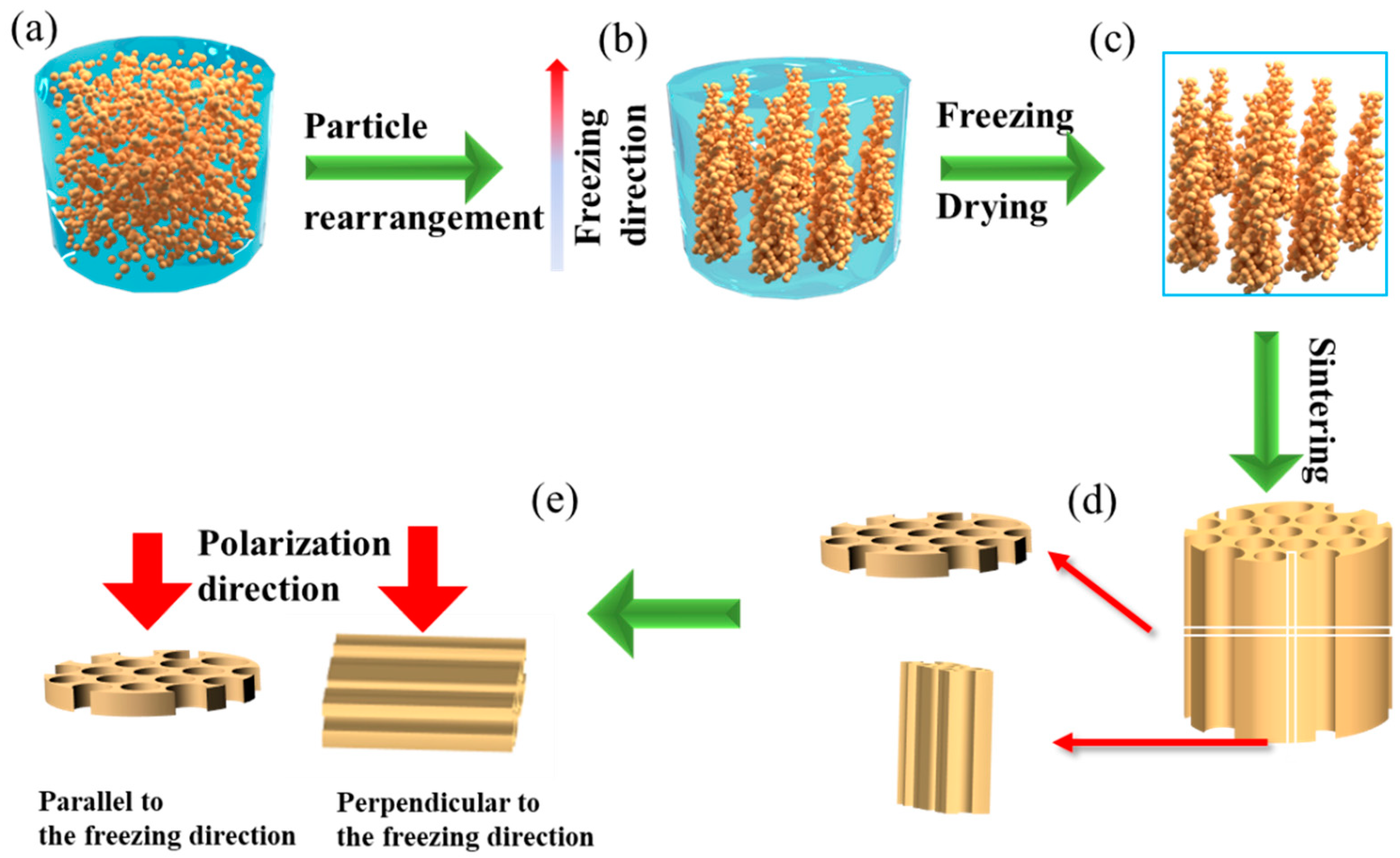
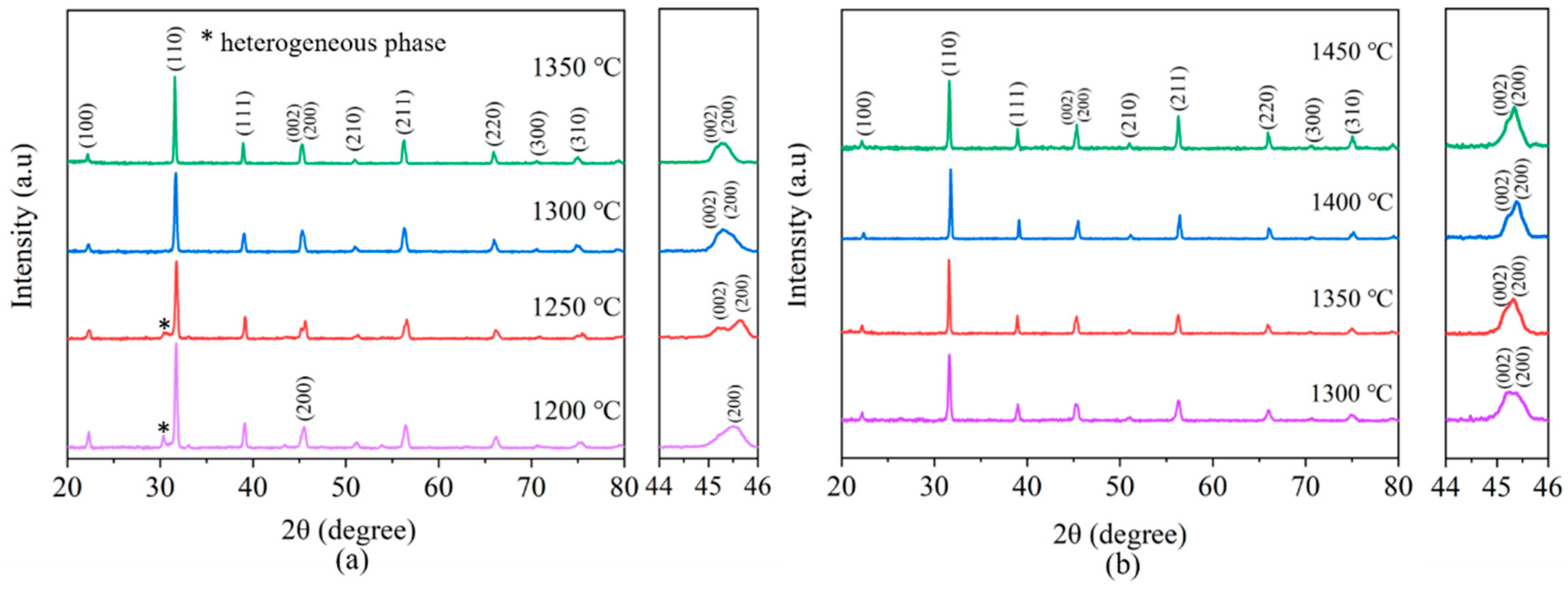


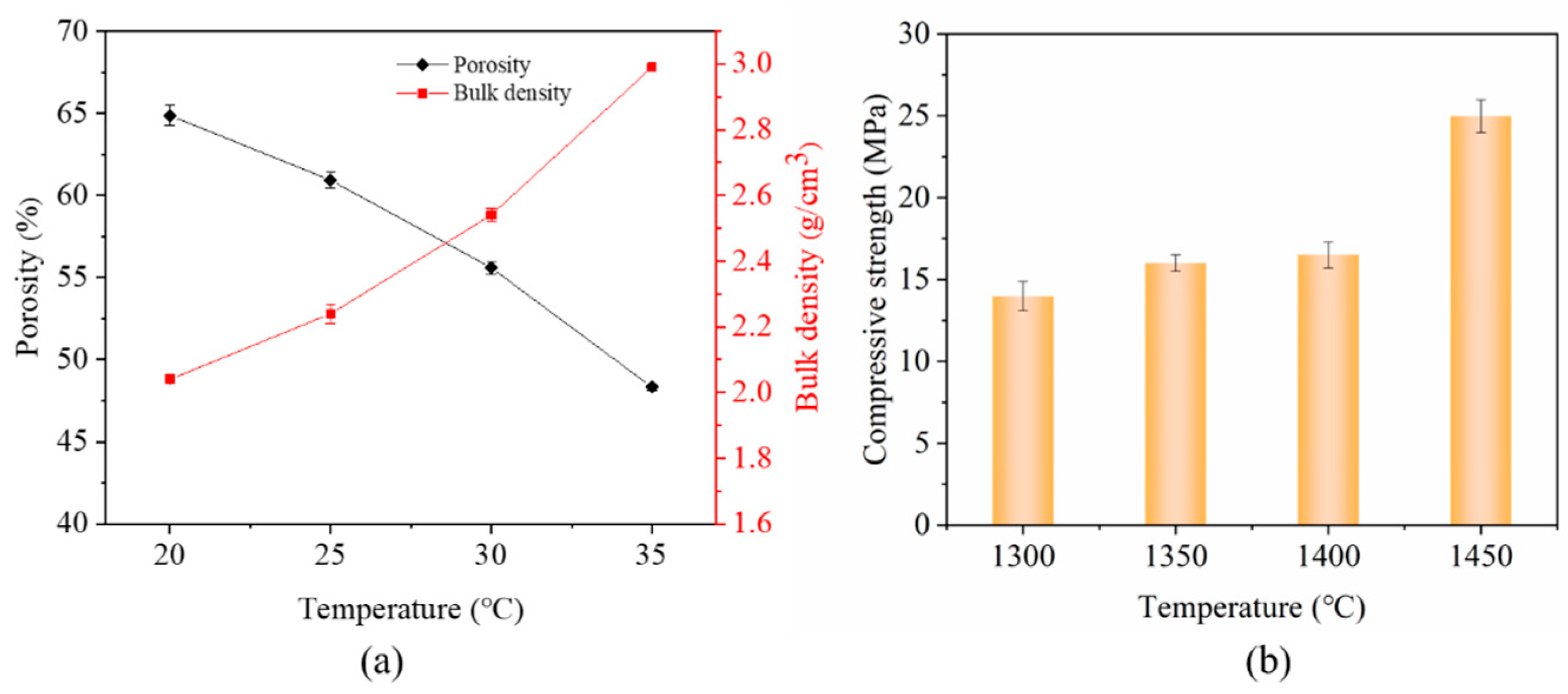
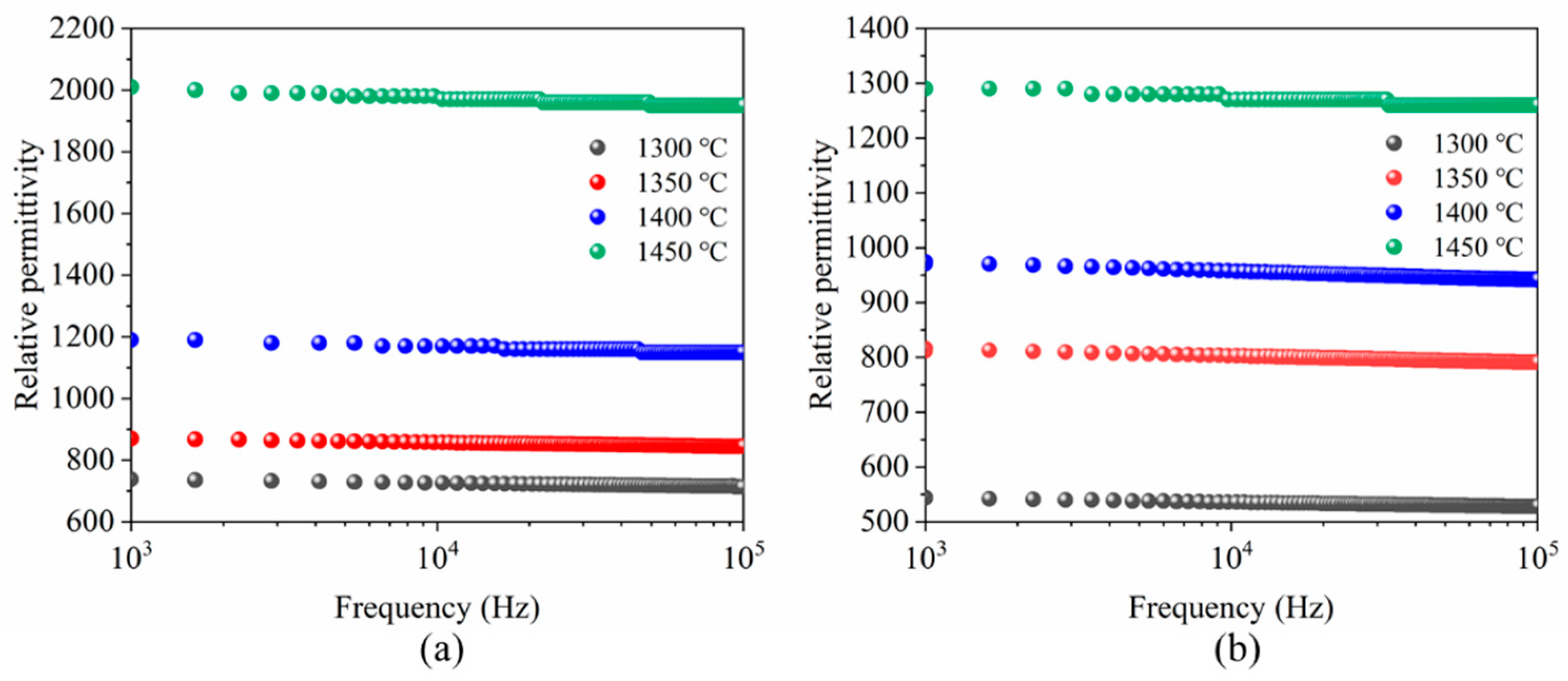
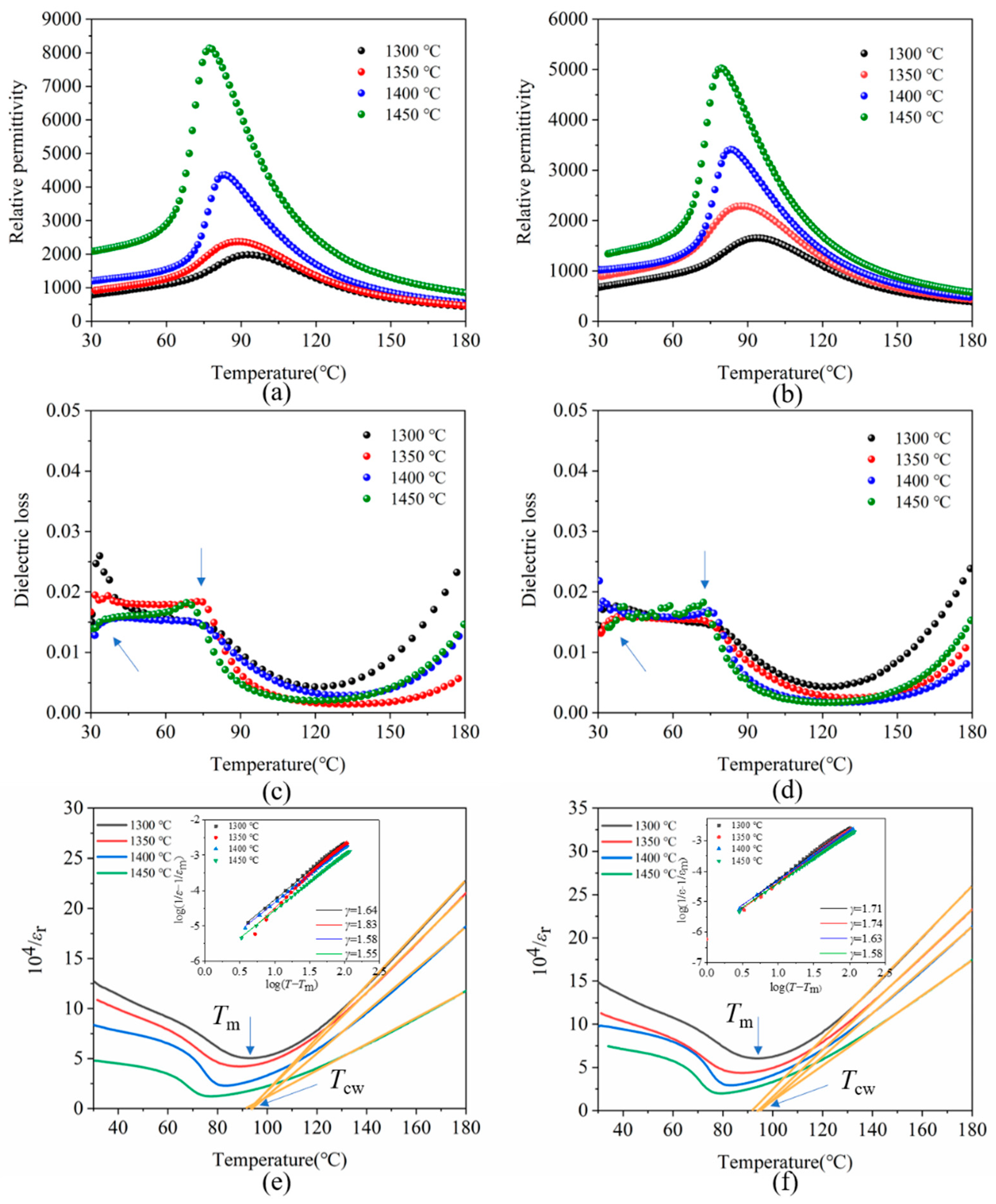
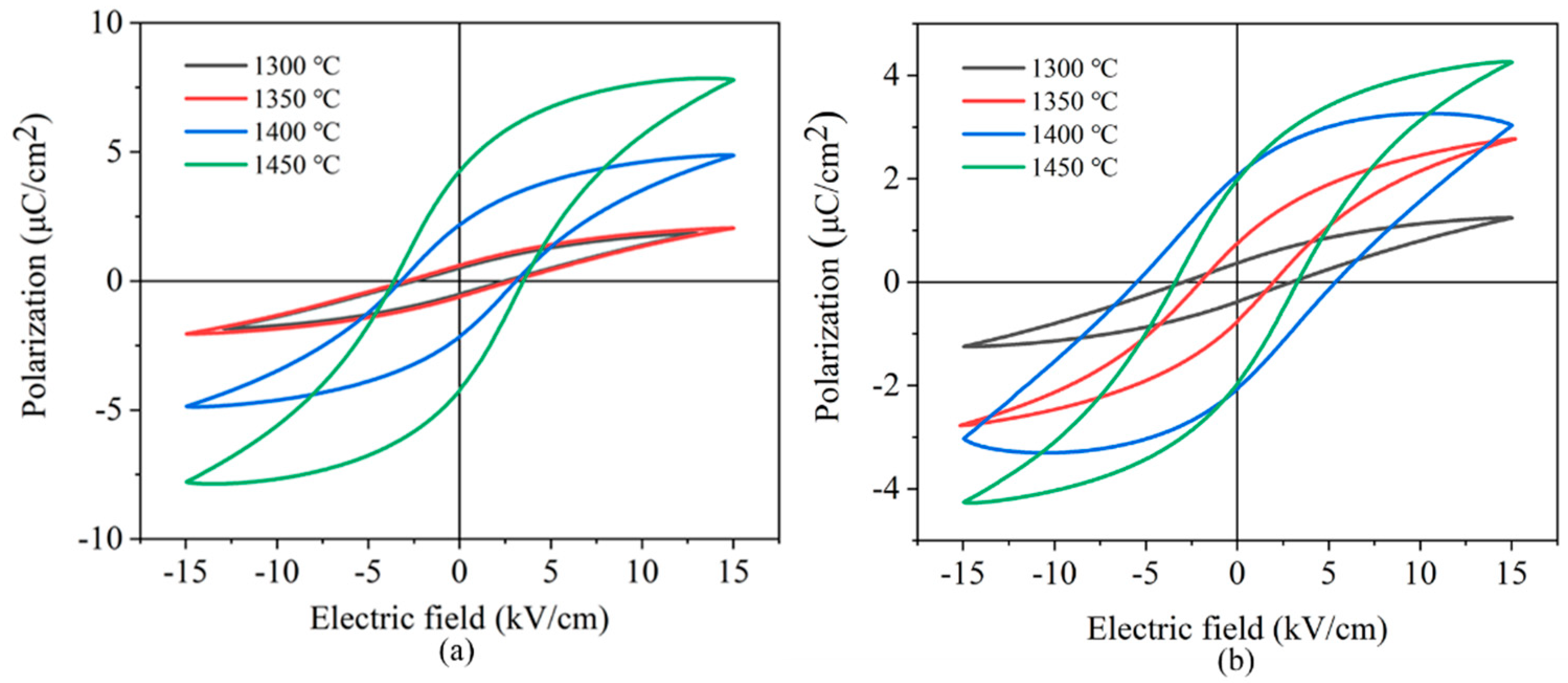
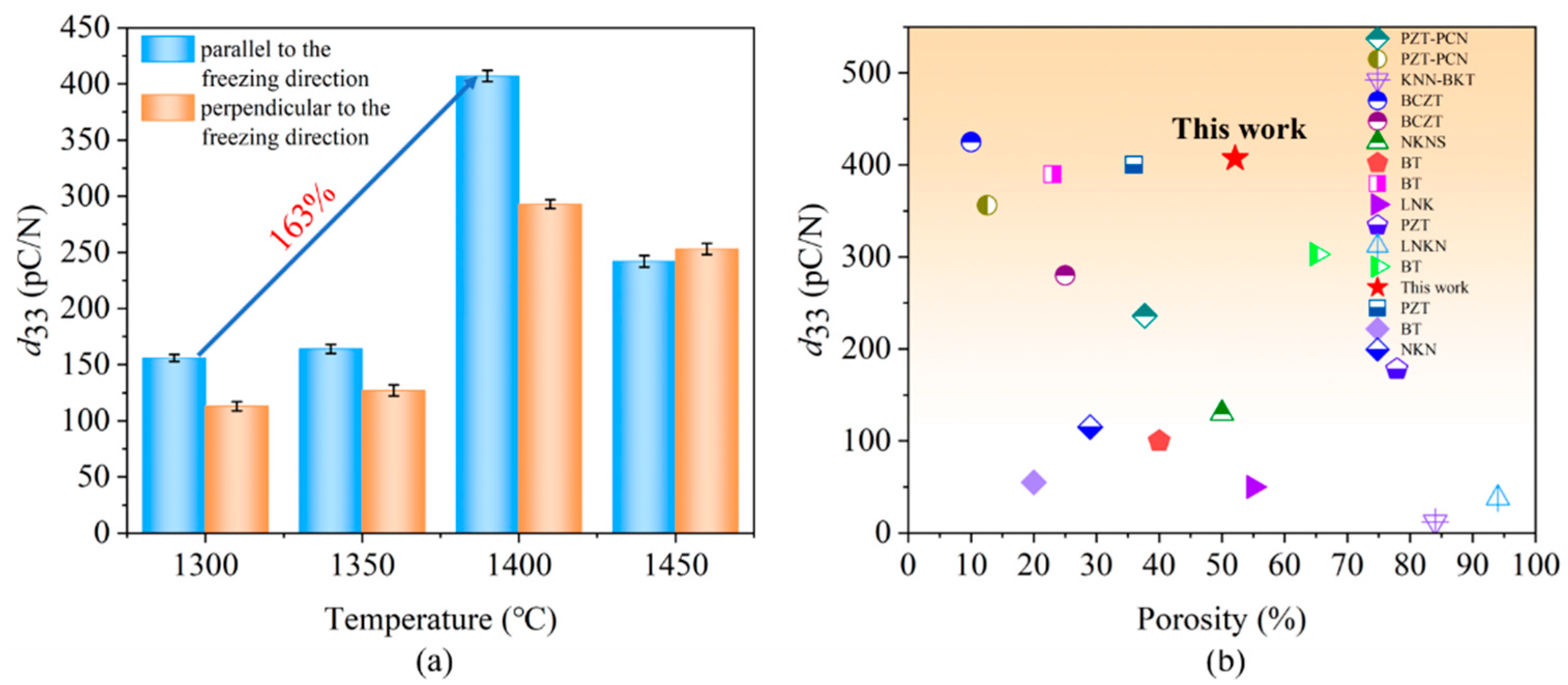
| 1300 °C | 1350 °C | 1400 °C | 1450 °C | ||
|---|---|---|---|---|---|
| (parallel to the freezing direction) | Ec (kV/cm) | 2.52 | 2.84 | 3.21 | 3.57 |
| Pr (μC/cm2) | 0.50 | 0.60 | 2.17 | 4.24 | |
| (perpendicular to the freezing direction) | Ec (kV/cm) | 2.84 | 1.98 | 5.49 | 3.39 |
| Pr (μC/cm2) | 0.37 | 0.74 | 2.06 | 1.97 |
Publisher’s Note: MDPI stays neutral with regard to jurisdictional claims in published maps and institutional affiliations. |
© 2022 by the authors. Licensee MDPI, Basel, Switzerland. This article is an open access article distributed under the terms and conditions of the Creative Commons Attribution (CC BY) license (https://creativecommons.org/licenses/by/4.0/).
Share and Cite
Ge, S.; Zhang, J.; Zhang, Y.; Shi, P.; Wang, H.; Liu, S.; Tian, Z.; Shi, Z. Anisotropic Piezoelectric Properties of Porous (Ba0.85Ca0.15)(Zr0.1Ti0.9)O3 Ceramics with Oriented Pores through TBA-Based Freeze-Casting Method. Materials 2022, 15, 3820. https://doi.org/10.3390/ma15113820
Ge S, Zhang J, Zhang Y, Shi P, Wang H, Liu S, Tian Z, Shi Z. Anisotropic Piezoelectric Properties of Porous (Ba0.85Ca0.15)(Zr0.1Ti0.9)O3 Ceramics with Oriented Pores through TBA-Based Freeze-Casting Method. Materials. 2022; 15(11):3820. https://doi.org/10.3390/ma15113820
Chicago/Turabian StyleGe, Siyu, Junzhan Zhang, Ying Zhang, Peng Shi, Honghui Wang, Shangyi Liu, Zhifeng Tian, and Zongmo Shi. 2022. "Anisotropic Piezoelectric Properties of Porous (Ba0.85Ca0.15)(Zr0.1Ti0.9)O3 Ceramics with Oriented Pores through TBA-Based Freeze-Casting Method" Materials 15, no. 11: 3820. https://doi.org/10.3390/ma15113820
APA StyleGe, S., Zhang, J., Zhang, Y., Shi, P., Wang, H., Liu, S., Tian, Z., & Shi, Z. (2022). Anisotropic Piezoelectric Properties of Porous (Ba0.85Ca0.15)(Zr0.1Ti0.9)O3 Ceramics with Oriented Pores through TBA-Based Freeze-Casting Method. Materials, 15(11), 3820. https://doi.org/10.3390/ma15113820







